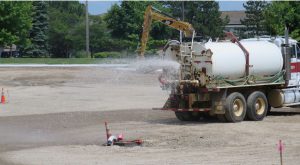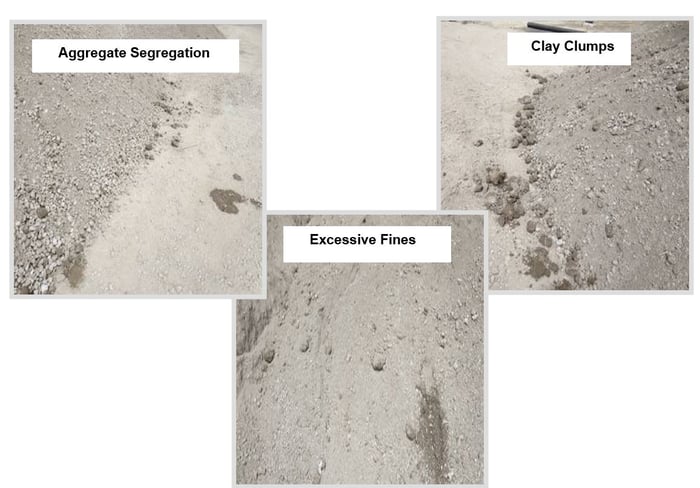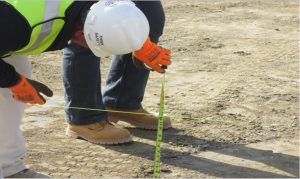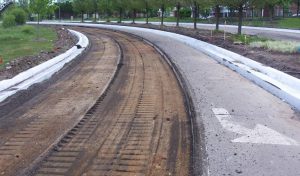 By Daniel E. Wilson, PE
By Daniel E. Wilson, PE
Senior Consultant
Any pavement rehabilitation project, regardless of size, can benefit from employing a construction observation professional. Construction observation of a pavement rehabilitation project includes three advantages for the client: (1) safeguard quality, (2) manage costs, and (3) reduce risk. The following are qualities of each of these benefits, what is involved, and what you should expect from construction phrase services.
SAFEGUARD QUALITY
Construction observation contains many aspects associated with quality on your projects, from conception to final acceptance. Quality starts early in the process and includes proper preparation of specifications, plans and details, contractor selection, and contractor pre-qualification. Project quality also increases by having a pre-bid meeting, preconstruction meeting, and proper review of product and material submittals.
On-site activity to improve quality includes material quality assurance, site observations, daily construction reports, and weekly progress meetings. While specifications, plans, and details play a significant role in a quality project, this article addresses the process after specifications and construction plans are ready for distribution to contractors for pricing. A complete set of documents should be site-specific and easy to understand with thorough specifications that include details, phasing plans, and a traffic control plan.
Contractor Selection and Pre-Qualification
Benchmark has a pre-qualification process through which the bidding contractors’ prior experience, job size, owned equipment, and references are researched and verified. Pre-qualification is performed to obtain a level of assurance for the client that the contractor can complete the scope of work for the specific project. Some things to consider include: Is the contractor an installer, producer, or both; are they a local contractor, regional contractor, or national vendor; and how much of the work are they capable of self-performing? References for similar projects should also be considered.
Pre-Bid Meeting
A pre-bid meeting is a great way to convey the complexity or simplicity of the project. This meeting is the best time for bidders to familiarize themselves with site conditions, traffic count and patterns, and to see facility utilization firsthand. It is an opportunity for the facility to inform bidders of their operation’s flow so work will progress with as little disruption to the business as possible. The pre-bid meeting is also an opportunity for bidders to ask questions and express concerns, and for the consultant to present the overall project scope of work while reviewing project documents. A walk-through is very helpful for bidders and gives them a good understanding of the project.
Preconstruction Meeting
A preconstruction meeting is highly recommended for any project, large or small. On smaller, short-term projects, this may be the only scheduled meeting between all parties. On large projects, a preconstruction meeting will establish the lines of communication, confirm the schedule, and discuss the final project phasing plan. Usually, this will be the first of weekly scheduled progress meetings that will review the contractor’s progress towards timely completion. With the schedule reviewed, the phasing plan and traffic control needs can be discussed with the client to see what impact the work will have on facility production if any.
Products and Materials Review
Once bids are received, a thorough review of all proposals submitted, including a bid tabulation to compare pricing, helps establish the best qualified bidder for the contract award. When award of the project is complete, approval of products and materials begins. A list of products and materials requiring submittal and approval should be included in the specifications as this information represents the basis of what the contractor needs to submit. As submittal items are reviewed for compliance, a list with comments and status of items is updated, indicating either approved for use or rejected. Asphalt or concrete materials may require additional supporting test results to determine compliance with the project

Water truck applying water to aggregate base to aid with compaction efforts.
Site Work Begins
Construction observation and quality begin on the first day of construction with installation of soil erosion controls, if required, and inspection of delivered materials. A site inspection verifies that only approved products on the submittal log are being used. As work progresses, products and materials are checked routinely to verify whether they meet the project requirements. Some of these checks include proof rolling the grade; compaction, density, air, and slump tests; review of proper placement of reinforcing steel; and inspection of material temperature, depth, and yield checks. Proof rolling is a testing method that determines whether a site’s substrate can support a given load. It involves running a fully loaded dump truck or water truck over the substrate (grade) whether it is subgrade, aggregate base, or a milled pavement surface. Proof rolling will determine if any unstable areas exist.
When yielding is identified and additional stability is needed, undercutting or stabilization may be required. Once the grade or aggregate surface is stable, testing is performed for density compliance. A nuclear density gauge calibrated to a laboratory sample of the tested material is used to determine if the compactive effort is achieving the required density. Results determine the optimum moisture content at which a given soil or aggregate type becomes most dense. Provided the tests pass, placement of pavement can begin. If tests do not pass, rolling the subgrade or aggregate for density will continue. If properly used compaction equipment is unable to produce desired results, then the addition of water or mechanical drying of material is performed. Optimum moisture content of the construction material is essential to compaction and can often be overlooked during construction.
Material Quality Assurance
Some people may inquire about the difference between quality control and quality assurance. Quality control (QC) is the contractor’s in-house or outsourced QC program. Quality control tests are continually performed to monitor compliance with the specifications of manufactured or installed materials. The focus of quality assurance (QA) testing provides confidence that requirements per the specifications are adhered to through verification of QC testing frequency and results. A considerable portion of the QA requires observation of the temperature and density tests performed on the grade or asphalt pavement. An independent testing company is used to verify QC testing of material property compliance. Samples of asphalt materials should be appropriately obtained, packaged, recorded, and sent to an independent testing company to determine compliance with the specifications. For concrete pavement, QA is observation of the density test performed on the grade along with temperature/slump/air tests, and making and proper curing of the cylinders. Concrete cylinders are tested for compressive strength at intervals of 2 to 3 days, 7 days, and 28 days. Compressive tests are used to determine strength compliance of the concrete to the specifications.

Site observations of qualities of aggregate observed in the field to verify conformance to specifications.
Site Observations
Typical daily construction observation includes the following tasks:
- Determine whether workers are performing jobs they are qualified to do.
- Monitor workmanship for proper construction methods.
- Witness proof rolling of subgrade, aggregate surface, or a milled surface.
- Verify delivered materials are listed as approved for use.
- Confirm the installation of construction materials is correct.
- Record temperature of delivered asphalt and concrete materials.
- Witness reinforcing steel placement to proper layout, size, embedment, and support.
- Record and verify depth and thickness of installed materials.
- Perform real-time audits to check material yields.
- Verify proper paving direction, size of panels, and joint layout.
- Ensure installed materials remain protected from damage.
- Communicate with supervisor on the daily work plan.
- Discuss with supervisor the goals for the following day’s operations.
- Prepare daily job reports with photo documentation.
- Verify and document quantities of work completed.
MANAGE COSTS
Managing costs begins at the design stage when preparing site-specific construction documents. A correctly designed pavement cross-section will support the given loads/usage and allow future rehabilitation to produce sustainable pavements. Information used for a proper pavement design includes knowledge gained from prior work performed at the site, lessons learned from previous work, and pavement cores and soil borings associated with a geotechnical investigation. The long-term cost benefits of a pavement that can be maintained or rehabilitated without the need for full reconstruction determine future costs.
A couple of ways to manage costs throughout a construction project are part of the Quality portion of this article. Costs can be monitored and managed daily by performing real-time audits and checking material yields. In working with the client and contractors through daily communication, the duration of the project can be reduced. By maximizing crews, equipment efficiency and production, projects can stay ahead of schedule.
Grade Control

Verify elevations of grade from string line referenced from grade stakes.
When the subgrade or grade is correct, material usage is also accurate. Aggregate base or subbase materials have a material-specific unit weight determined through laboratory testing to find the maximum density the materials will achieve. Each specific unit weight is used to determine the theoretical amount of construction material used in a given area at design depth. The project superintendent is made aware of the amount of material calculated and what is required and agrees on the actual quantities of construction materials that should be used for that day.

Check asphalt pavement surface slope during paving operations.
Finished grade of the aggregate surface is essential. By understanding the elevation information on the survey stakes, a consultant can determine whether the subgrade or aggregate base is high or low. The tolerance for the finished aggregate surface is typically specified to be +/- ½ inch of the planned grade. Many specifications require that the minimum thickness is achieved instead of average thickness. Therefore, the grade difference must be exact or deeper, but not less than the design depth, thereby not accepting any grade that is on the high side of industry tolerances.
Asphalt Control
Installed asphalt material is approximately 5 to 6 times the cost of installed aggregate base. Therefore, control of material usage of the asphalt pavement can have a significant effect on the budget and structural value of the final pavement. An ideal situation would be to have the grade exactly at design depth throughout the entire site. The reality of site work is that final grade can be slightly inconsistent due to variances allowed as a result of equipment capabilities. Construction specifications call out acceptable tolerances, and the bid documents account for material variances. Constant monitoring of material used throughout the day and reporting this information to the superintendent will ensure proper thickness and volume of construction materials are installed on a daily basis and are in compliance with the specifications.

Verify asphalt pavement surface depth prior to compaction.
Design and Specify for Optimum Equipment Production
Having knowledge of construction equipment capabilities is valuable when specifying work to be performed on the site. While designers cannot always determine the means and methods to achieve the desired result, they can call out minimum size or weight of equipment used. For example, when pavement removal is required and the site is large enough to accommodate a pavement milling machine, the removal is specified to be with a mill. Milling has an advantage over the excavation method by being faster and less disruptive to the grade versus wheeled equipment. If the site is too confined or other conditions do not allow milling, then pavement removal can be specified by excavation. However, track driven equipment may be called out to be used to minimize disturbance to the grade. Also, it may be economical and practical to expand a small area of pavement to accommodate a more cost-effective process to keep unit prices in line.

Pavement removal by milling can minimize disruption to the grade and be more efficient, saving time and cost.
Keep Contractor on Schedule with Next Day and Weekly Plans
It is always a good idea to schedule weekly progress meetings, provided the project is more than two weeks in duration. As a requirement, during the planned weekly progress meeting, the contractor should have present persons directly involved with the project including subcontractors, and vendors. Another requirement should be the development and distribution of a written progress schedule detailing the next two weeks of work. Written schedules are used to document the weekly job progress. As a result of following this process, information is easy to transmit to others involved with the project as some may not be directly involved with the day-to-day field operations.
REDUCE RISK
OSHA-Trained- Having construction workers and a construction observation professional who is OSHA-trained is a benefit. By having an independent expert looking out for the safety of the client’s assets and personnel, as well as the workers on site, the risk for loss can be reduced. Some of the items include:
- Ensure proper barricading is in place for both pedestrian and vehicle traffic safety.
- Verify workers are performing tasks with the appropriate personal protective equipment (PPE) in place.
- Verify equipment and tools are being used correctly and as intended with all protective guards in place.
In addition to proper traffic control, a safe work perimeter must be maintained to give the contractor an adequate area to work and maneuver equipment safely while maintaining other aspects of the facility’s daily traffic.
Many steps go into any pavement project, regardless of size or scope. By following the actions referenced in this article, pavements can be constructed with minimal project-related issues. Utilizing experienced personnel in all aspects of the project, from design to construction, will help to obtain a high quality, timely, and reasonably priced project with little disruption.
